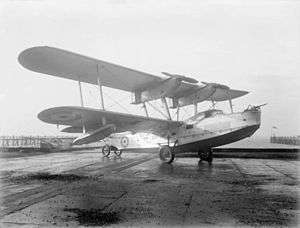Supermarine Scapa
| Scapa | |
|---|---|
 | |
| Role | Reconnaissance flying boat |
| Manufacturer | R.J. Mitchell |
| First flight | 1932 |
| Introduction | 1935 |
| Primary user | Royal Air Force |
| Number built | 15 |
| Developed from | Supermarine Southampton |
The Supermarine Scapa was a British general reconnaissance flying boat built by Supermarine that was used by the Royal Air Force between 1935 and 1939. It was developed from the Southampton and formed the basis of the later Stranraer flying boat.
Development
After experimenting with a three-engine design of flying boat, (the Nanuk/Solent/Southampton X), Supermarine's chief designer, R.J. Mitchell, decided that the good hydrodynamic design that had been developed in the twin-engined Southampton, would be the platform for the next aircraft.
A prototype designated the Southampton IV was built. It had a hull that performed even better in the tank tests. An Air Ministry Specification was received in November 1931. The test pilot Joseph "Mutt" Summers took the first flight on 8 July 1932. The name had then been changed to the Scapa.
15 Scapas were built before production was changed to a more powerful development, the Stranraer.
Design
The Scapa hull was an all-metal structure. The wing and tail surfaces had metal structure with fabric covering. The engines were mounted in nacelles underslung from the upper wing, There were two fins, each placed at the mid semi-span of the tailplane. Similar to the Southampton, there were three gun positions provided, one in the nose and two staggered in the rear fuselage.
Operators
Specifications (Scapa)
Sourced from [1]
General characteristics
- Crew: Five
- Length: 53 ft (16.2 m)
- Wingspan: 75 ft (22.85 m)
- Height: 21 ft (6.4 m)
- Wing area: 1,300 ft² (121 m²)
- Empty weight: 10,030 lb (4,500 kg)
- Loaded weight: 16,080 lb (7,290 kg)
- Powerplant: 2 × Rolls-Royce Kestrel IIIMS Water-cooled V12, 525 hp (392 kW) each
Performance
- Maximum speed: 123 kn (142 mph, 229 km/h)
- Range: 870 nmi (1000 mi, 1610 km)
- Service ceiling: 15,500 ft (4,720 m)
- Rate of climb: 625 ft/min (3.25 m/s)
- Wing loading: 12.3 lb/ft² (60.2 kg/m²)
- Power/mass: 0.065 hp/lb (0.107 kW/kg)
- Climb to 9,840 ft (3000 m): 20 minutes
Armament
- Guns: 3 × 0.303 in (7.7 mm) Lewis guns, one in bow and two amidships
- Bombs: 1,000 lb (454 kg) bombload under the wings
See also
- Related development
- Aircraft of comparable role, configuration and era
- Related lists
References
- ↑ Andrews & Morgan
Bibliography
| Wikimedia Commons has media related to Supermarine Scapa. |
- Andrews, CF; Morgan, EB (1987). Supermarine Aircraft since 1914 (2nd ed.). London: Putnam. ISBN 0-85177-800-3.
- Shelton, John (2008). Schneider Trophy to Spitfire - The Design Career of R.J. Mitchell (Hardback). Sparkford: Hayes Publishing. ISBN 978-1-84425-530-6.